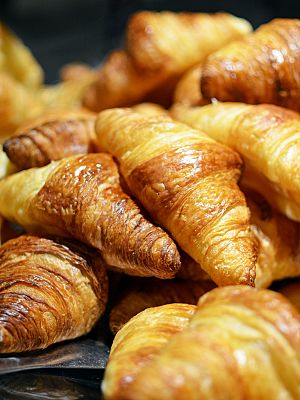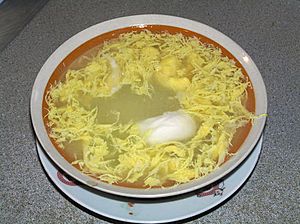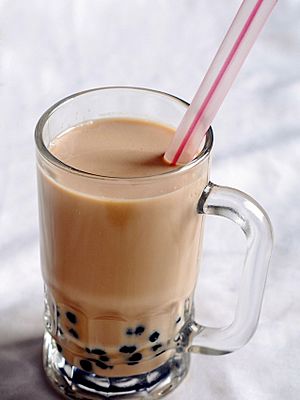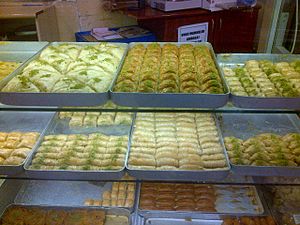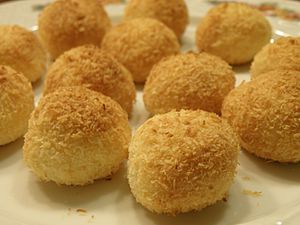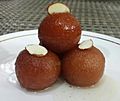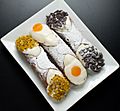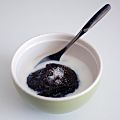Dessert facts for kids
A dessert is a type of food eaten after lunch or dinner. It's usually a sweet food, like ice cream, cookies, and cakes. In some countries, cheeses such as Brie and fruit are served as dessert. Some desserts are decorated, like birthday cakes. Others are simple, like pudding. Many desserts are baked (cooked in an oven). Some are served with whipped cream on top.
Contents
What Are Desserts Made Of?
Sweet desserts usually contain sugar, like cane sugar, palm sugar, or honey. They might also have syrups like molasses or maple syrup. Other common ingredients in Western desserts are flour, starches, and fats like butter. Dairy products, eggs, salt, and acidic ingredients like lemon juice are also used. Spices and flavors such as chocolate, peanut butter, fruits, and nuts add taste. The amounts of these ingredients and how they are prepared change the dessert's texture and flavor.
Sugars add moisture and softness to baked goods. Flour or starch gives the dessert its structure. Fats add moisture and can create flaky layers in pastries and pie crusts. Dairy products in baked goods help keep desserts moist. Many desserts also have eggs. Eggs can form custards or help cakes rise and thicken. Egg yolks make desserts richer. Egg whites can help things rise or give structure. Today, there are also vegan and gluten-free options for these ingredients. Desserts can have many spices and extracts for different flavors. Salt and acids are added to balance sweet flavors and create a nice contrast.
Some desserts are made with coffee, creating coffee-flavored treats like iced coffee soufflés or coffee biscuits. Alcohol can also be used as an ingredient.
Different Kinds of Desserts
Desserts come in many flavors, textures, and looks. A dessert is usually a sweet course that finishes a meal. This can be anything from fruits or dried nuts to fancy cakes and pies. Many cultures have their own special desserts. Often, dessert types have been passed down through generations or come from specific places. Here are some main types of desserts.
Biscuits and Cookies
Biscuits, also called "cookies" in North America, come from an Old French word meaning "twice-baked." They are flat, bite-sized or larger pastries, usually eaten by hand. Biscuits can be crispy, chewy, or soft. Examples include layered bars, crispy meringues, and soft chocolate chip cookies.
Cakes
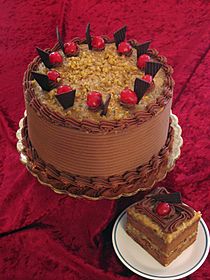
Cake Cakes are sweet, soft breads made with sugar and fine flour. They can be light and airy, like sponge cakes, or dense with less flour. Common flavors include dried, candied, or fresh fruit, nuts, cocoa, or extracts. Cakes might be filled with fruit preserves or dessert sauces like pastry cream. They are often covered with buttercream or other icings and decorated. Cake is often served for special events like weddings, anniversaries, and birthdays. Small cakes like cupcakes and petits fours are also very popular.
Chocolates and Candies

Chocolate|Candy Chocolate is a sweet, usually brown, food made from Theobroma cacao seeds. These seeds are roasted, ground, and often flavored. Pure chocolate has cocoa solids and cocoa butter. Most chocolate eaten today is sweet chocolate, which combines chocolate with sugar. Milk chocolate also has milk powder. White chocolate has cocoa butter, sugar, and milk, but no cocoa solids. Dark chocolate has fat and sugar added to the cacao mix, with little or no milk.
Candy, also called sweets or lollies, is a sweet treat where sugar is the main ingredient. Many candies involve sugar crystals forming in different ways, which changes their texture. Candies come in many forms, including caramel, marshmallows, and taffy.
Custards and Puddings

Custard|Pudding These desserts usually have a thick dairy base. Custards are cooked and thickened with eggs. Baked custards include crème brûlée and flan. Puddings are thickened with starches like cornstarch or tapioca. Custards and puddings are often used as fillings for other desserts, such as pastries or pies.
Deep-Fried Desserts
Many cultures have desserts made from deep-fried batter or dough. A doughnut is a deep-fried, flour-based batter, sometimes filled with custard or jelly. Fritters are fruit pieces in thick batter that are deep-fried. Gulab jamun is an Indian dessert made from milk solids, deep-fried, and soaked in honey. Churros are deep-fried, sugared dough eaten as a dessert or snack in many countries. Doughnuts are famously a favorite of Homer Simpson from The Simpsons.
Frozen Desserts
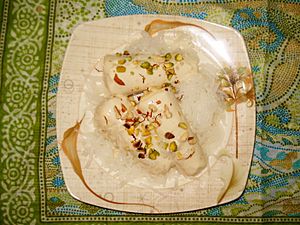
Ice cream| Ice cream, gelato, sorbet, and shaved-ice desserts are in this group. Ice cream is a cream base that is churned while freezing to become creamy. Gelato uses a milk base and has less air whipped in, making it denser. Sorbet is made from churned fruit and has no dairy. Shaved-ice desserts are made by shaving a block of ice and adding flavored syrup or juice.
Jellied Desserts
Jellied desserts are made with a sweetened liquid thickened with gelatin or other agents. They are traditional in many cultures. Grass jelly and annin tofu are Chinese jellied desserts. Yōkan is a Japanese jellied dessert. In English-speaking countries, many dessert recipes use gelatin with fruit or whipped cream.
Pastries
Pastry Pastries are sweet baked goods. They can be light and flaky, like a croissant, or a crispy, high-fat dough, like shortbread. Pastries are often flavored or filled with fruits, chocolate, nuts, and spices. Sometimes, pastries are eaten with tea or coffee for breakfast.
Pies, Cobblers, and Clafoutis
Pie Pies and cobblers have a crust with a filling. The crust can be made from pastry or crumbs. Pie fillings range from fruits to puddings. Cobbler fillings are usually fruit-based. Clafoutis are a batter with a fruit filling poured over the top before baking.
Sweet Soups
Tong sui, meaning "sugar water," is a term for any sweet, warm soup or custard served as dessert in Cantonese cuisine. Tong sui are a Cantonese specialty and are rare in other Chinese cuisines. Outside of Cantonese-speaking areas, soupy desserts are not usually seen as a separate category.
Dessert Wines
Dessert wines are sweet wines often served with dessert.
Desserts Around the World
Desserts are enjoyed differently across continents, often reflecting local ingredients and traditions.
African Desserts
In much of central and western Africa, there isn't a tradition of a dessert course after a meal. Instead, fruit or fruit salad might be eaten, sometimes spiced or sweetened. In some former colonies, the desserts show the influence of the colonial power. For example, Angola's cocada amarela (yellow coconut) is similar to baked desserts from Portugal.
Asian Desserts
In Asia, desserts are often eaten as snacks between meals rather than as a final course. Many East Asian desserts use rice flour and local ingredients like coconut milk, palm sugar, and tropical fruit. In India, where sugarcane has been grown for thousands of years, desserts have always been important. Types of Indian desserts include burfis, halvahs, jalebis, and laddus.
Today, desserts are even made into drinks, like Bubble Tea. It started in Taiwan, East Asia. Bubble tea is a dessert drink made with flavored tea or milk and tapioca pearls. It is now popular worldwide.
Eurasian Desserts
In Ukraine and Russia, breakfast foods like nalysnyky or blintz (pancakes), and syrniki are served with honey and jam as desserts.
North American Desserts
When Europeans came to the Americas, they brought new ingredients and cooking styles. These styles kept growing through the 1800s and 1900s as more immigrants arrived. This led to a wide variety of desserts in North America.
South American Desserts
Dulce de leche is a very common sweet in Argentina. In Bolivia, sugarcane, honey, and coconut are often used in desserts. Tawa tawa is a Bolivian sweet fritter made with sugarcane. Helado de canela is a sherbet-like dessert made with cane sugar and cinnamon. Coconut tarts, puddings, cookies, and candies are also eaten in Bolivia. Brazil has many candies like brigadeiros (chocolate fudge balls), cocada (a coconut sweet), beijinhos (coconut truffles), and romeu e julieta (cheese with guava jam). Peanuts are used to make paçoca, rapadura, and pé-de-moleque. Local fruits are made into juices, chocolates, popsicles, and ice cream. In Chile, kuchen is a well-known dessert. Many Chilean desserts use manjar (caramelized milk), including alfajor, flan, cuchufli, and arroz con leche. Desserts in Colombia include dulce de leche, waffle cookies, puddings, nougat, coconut with syrup, and thickened milk with sugarcane syrup. Desserts in Ecuador are usually simple and a moderate part of the food. These include tres leches cake, flan, candies, and various sweets.
Oceanian Desserts
Desserts are commonly eaten in Australia. Most daily meals "end with simple desserts," which can include various fruits. More complex desserts like cakes, pies, and cookies are sometimes served for special events.
The Dessert Market
The market for desserts has grown a lot in recent decades. This was helped by the commercial baking of desserts and the rise of food production companies. Desserts are now found in most restaurants because they are so popular. Many stores are now dedicated only to desserts. Ice cream parlors have been around since before 1800. Many businesses started advertising campaigns just for desserts. How desserts are advertised depends on who they are for. For example, desserts can be advertised with popular movie characters to attract children. The rise of companies like Food Network has created many shows about desserts and how they are made. These shows have featured amazing desserts and created a game show feel, making desserts a more competitive area.
Desserts are a regular part of restaurant menus, with different levels of variety. Pie and cheesecake were among the most popular desserts ordered in U.S. restaurants in 2012.
Images for kids
-
The spread of sugarcane from ancient India to the world.
-
Some Indian confectionery desserts. In parts of India, these are called mithai or sweets. Sugar and desserts have a long history in India: by about 500 BC, people in India had developed the technology to produce sugar crystals. In the local language, these crystals were called khanda, which is the source of the word candy.
-
German chocolate cake, a layered cake filled and topped with a coconut-pecan frosting.
-
Gulab jamun topped with almond slivers is one of the most popular sweets from the Indian subcontinent.
-
Cendol Akaka in Johor Bahru Shopping Centre.
-
Baked custard.
-
Cannoli with pistachio dust, candied and chocolate drops.
-
Homemade banana pudding.
-
Flan, a type of custard.
See also
 In Spanish: Postre para niños
In Spanish: Postre para niños


